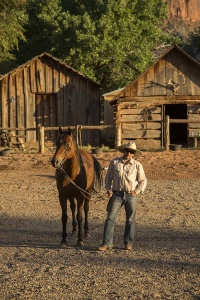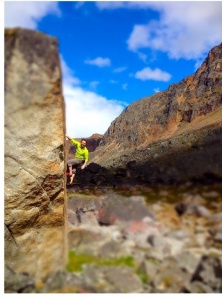James Q. Martin travels all over the world to document wild places and conservation efforts. Simply put, his films and photos tell the story of Mother Earth.

A nomadic childhood can lead to a broad worldview and a curious perspective on life. James Q. Martin has stayed inquisitive and wandering since he was small.
Born in Arizona, he traveled and lived in a van with his free-spirited parents far before “van life” was a hashtag. Martin lived in a “communal situation” in Oregon as a kid and moved to Alaska while he was young. Most of his time he spent following his mother on hiking trails and camping in the wide-open wild.

“Time with my grandparents was probably the biggest influence on me as far as being outside and really understanding the rhythms of nature,” Martin said. “I would spend weeks with my grandmother, fishing and camping on remote rivers in Alaska. I think those experiences really connected me to Mother Nature.”
Photography always fascinated him. But he never considered himself a photographer until a trip to Central America during a break from college. He met and befriended professional photographer Xavier Chanut, who took Martin under his wing and the two shot photos all over Central America. Martin was hooked and since dedicated his life and career to visual storytelling and conservation efforts.
Interview: Filmmaker James Q. Martin
What are your career-defining projects?

My biggest project is probably The Rios Libres project. We worked on keeping mega hydroelectric power out of Patagonia, Chile.
I’m currently working on a film called The Cowboy and The Climber, which juxtaposes my life with head rancher and lifetime resident of The Dugout Ranch, Matt Redd.
Lately, a lot of the proposals for future projects seem to be associated with protection of our public lands, bringing more awareness to the realities of the current administration’s desire to take public lands out of our hands and give them to the state, where they can be manipulated. We want to help protect these places and their recreational enjoyment.
We just finished a series of films for Protect Our Winters, which I find inspiring and fun. One on the climate march in D.C. and another called Dear Mr. President. We interviewed 28 different kids, ages 5 to 14, about the realities of climate change and why the Paris Agreement is important. Their answers really inspired me.
When was the “yeah, I’m a filmmaker. I’m an activist” moment?
Probably when I started touring with my first film, Power In the Pristine in 2011. I saw the personal reactions people had to the film and how we were a part of the groundswell of so many different issues.
We were able to stop the proposed mega hydroelectric dams in Patagonia. It made me realize I was an activist and filmmaker and I was helping make change.
What are some concrete actions we can take to help?
I think the biggest thing we can do to be activists is to make sure that we vote. Take time to look at the issues associated with land and conservation, the social issues, and come to the ballot boxes educated.
It’s also very important to write to Congress and our local representatives, to inform them that we are educated on the issues. Make sure we keep pressure on them, let them know we are paying attention.
Just look at the recent fights in Utah. It’s necessary to pay attention to what’s going on with people like Congressman Chaffetz. He, Congressman Bishop, and others are undermining public lands. We have to put pressure on them. We need to let them know we are aware of these realities and we are not going to let them sell our public lands off.

Recently, I did a lot of work for Protect Our Winters, and one of the things we created was The Climate Activist’s Roadmap. It provides seven steps a person can take to bring awareness from an environmental perspective.
Activism can be as simple as volunteering with Big Brothers and Big Sisters, or organizations like GirlTrek, Latino Outdoors, or Outdoor Afro. These organizations open doors to people of color so they can experience the outdoors with mutual respect and opportunity.
There are outdoor organizations like Sierra Club and 350.org that offer a wide variety of volunteer options. They have a plethora of different opportunities for people to learn about the hot-topic items which need to be addressed.
Where do you draw inspiration?
One of my biggest inspirations was and is Kris Tompkins. She was a hero of mine before I ever met her and now I work with her and her organization on a very consistent basis.
Kris Tompkins and her late husband, Doug Tompkins, protected and donated more lands to conservation than anybody in history. She wrote a story featured in the Patagonia catalog, which was instrumental in my development as a conservationist.
I was really inspired by her words and her call to action. Initially, Yvon and Malinda Chouinard and all the work that Patagonia’s does and has done was a big influence and inspiration to me. And… everybody — the activists that are out there working to help protect our lands right now.

Why did you first pick up a camera and why do you still?
I’ve always been interested in telling stories and capturing the beauty of people and the environment. For me, the perfect image of blending both of those worlds together is ultimately the synergy that really inspires me.
What’s your process and style?
I’m kind of like a hunter. I observe, I watch. I take a lot of time to understand my subjects and my locations. I’ve always had a curious nature, been interested in who people are and why they do what they do. It stems from all those random people I met when I lived communally as a kid. I was always really curious to know more about what people were about and how they were choosing to live.
I take time to understand people, and also, I take time to get intimate with landscapes. For instance, I’ve been to Patagonia more than five times. As a young climber, I consistently went to Zion National Park, and for over a decade I spent more than a month of my life in the park, climbing, living, sleeping in the dirt, crashing on friend’s floors, sleeping in my van.
I feel like it’s a place that I know so well and it really helped me develop as a journalist and an athlete.
What do you want legacy to be?
I don’t know if I want a legacy. I don’t do the work I’m doing to be legendary. But I hope that the work I do inspires other artists to use their talents for the good of our society.
I think it’s important to realize that there’s a fight for what’s right in this world. I want to inspire people in all walks of life to give a shit and take the time to really be present and active on local, federal, and global issues.







